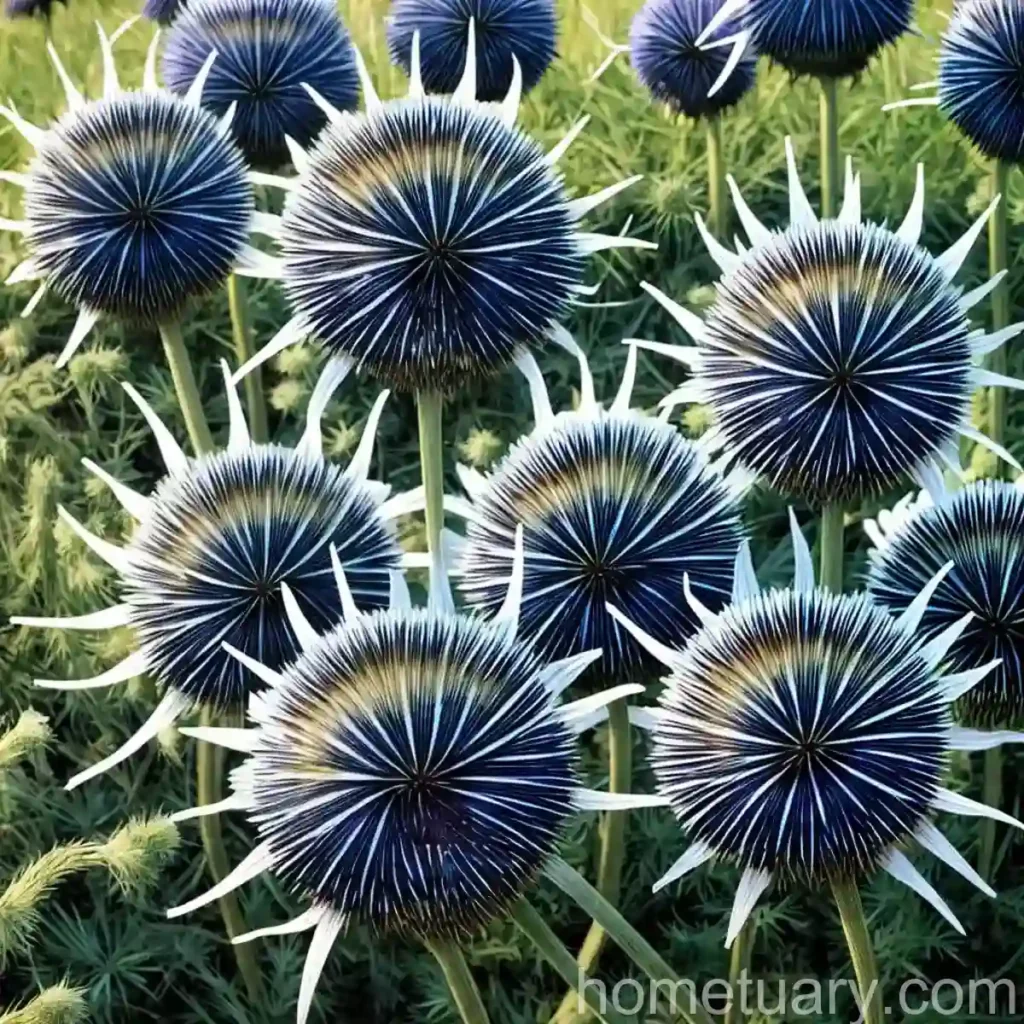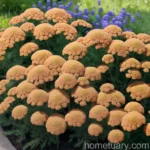The Great Globe Thistle (Echinops sphaerocephalus ‘Arctic Glow’)
Introduction
Plants are an essential part of our world, providing oxygen, food, and beauty to our environment. The great globe thistle, also known as Echinops sphaerocephalus ‘Arctic Glow’, is a stunning and versatile plant that is popular in gardens and landscapes. In this article, we will take an in-depth look at the characteristics, care tips, and uses of the great globe thistle, focusing on the variety ‘Arctic Glow’.
What is the Great Globe Thistle (Echinops sphaerocephalus ‘Arctic Glow’)?
The great globe thistle (Echinops sphaerocephalus ‘Arctic Glow’) is a captivating perennial plant known for its spherical flower heads and striking appearance. It belongs to the Asteraceae family and is native to parts of Europe and Asia. This variety, ‘Arctic Glow’, is particularly prized for its unique coloration, which adds an enchanting and ethereal quality to gardens and landscapes.
Key Takeaways – Great Globe Thistle (Echinops sphaerocephalus ‘Arctic Glow’)
Before delving into the details of care and cultivation, let’s explore some key takeaways about the great globe thistle, with a specific focus on the ‘Arctic Glow’ variety.
- Scientific Name: Echinops sphaerocephalus ‘Arctic Glow’
- Common Names: Great Globe Thistle ‘Arctic Glow’
- Family: Asteraceae
- Native Habitat: Europe, Asia
- Distinctive Features: Spherical flower heads, white and pale blue hues
- Landscape Uses: Ornamental gardens, naturalistic landscapes, cut flower gardens
- Attracts: Pollinators, beneficial insects
- Hardiness Zones: 3 to 8
- Flowering Period: Midsummer to early fall
- Maintenance: Low to moderate
Now that we have an overview of the great globe thistle (Echinops sphaerocephalus ‘Arctic Glow’), let’s delve into the specific aspects of its culture, uses, and maintenance.
Culture
Water
Great Globe Thistle (Echinops sphaerocephalus ‘Arctic Glow’) is known for its ability to thrive in dry conditions, making it an excellent choice for xeriscapes and drought-tolerant gardens. While it is relatively drought-resistant once established, young plants benefit from regular watering to encourage robust root development. During the growing season, water deeply when the soil feels dry to the touch, and reduce watering in the fall to prepare the plant for winter dormancy.
Sunlight
The ‘Arctic Glow’ variety of Echinops sphaerocephalus requires full sun to thrive and produce an abundance of flowers. Plant it in a location that receives at least 6 to 8 hours of direct sunlight per day. In areas with intensely hot summers, some afternoon shade may be beneficial to prevent heat stress, especially for young plants.
Fertilizer
Great globe thistle generally does not require heavy feeding and can thrive in nutrient-poor soils. However, incorporating organic matter such as compost into the soil before planting can provide an initial nutrient boost. Additionally, a balanced, slow-release fertilizer applied in early spring can support healthy growth and abundant flowering throughout the season. Avoid excessive nitrogen, as it can promote lush foliage at the expense of flowers.
Soil
This variety of Echinops sphaerocephalus prefers well-draining soil and is tolerant of various soil types, including sandy, loamy, or rocky soils. A slightly alkaline to neutral pH is ideal for optimal growth. Amending heavy clay soils with organic matter can improve drainage and create a more hospitable environment for the plant.
Pruning
Great Globe Thistle (Echinops sphaerocephalus ‘Arctic Glow’) generally requires minimal pruning, making it an excellent low-maintenance addition to the garden. However, removing spent flower heads can prolong the flowering period and encourage the plant to produce new blooms. In late fall or early spring, cut back the spent flower stems to tidy up the plant and prevent self-seeding if desired.
Propagation
The ‘Arctic Glow’ variety of Echinops sphaerocephalus can be propagated through division or seed.
Division: Every few years in early spring, the plant can be carefully divided to create new plants. Dig up the mature clump, and using a sharp, clean tool, separate the sections with healthy roots and shoots. Replant the divisions in prepared soil, and water them well to encourage establishment.
Seed: Collect seeds from the spent flower heads in the fall, and sow them in pots or directly in the garden in the spring. The seeds typically require a period of cold stratification to germinate, mimicking the natural conditions they would experience in the wild. Keep the soil consistently moist but not waterlogged, and the seeds should germinate within a few weeks to a couple of months, depending on environmental conditions.
Container Popularity
While great globe thistle (Echinops sphaerocephalus ‘Arctic Glow’) is commonly grown in garden beds and naturalistic landscapes, it can also thrive in containers given the right growing conditions. The large, architectural nature of the plant, combined with its unique flower heads, makes it a stunning addition to container gardens and patio displays. When growing ‘Arctic Glow’ in a container, ensure that the pot has adequate drainage, and select a well-draining potting mix to support healthy root development.
Container Common Diseases
In container settings, Echinops sphaerocephalus ‘Arctic Glow’ may be susceptible to similar diseases as those affecting plants grown in the ground.
Common diseases to watch for in container-grown great globe thistle include:
- Powdery Mildew: This fungal disease can manifest as a powdery, white substance on the leaves and stems of the plant, impacting its overall health and appearance.
- Root Rot: Poor drainage, overwatering, or soggy soil in containers can lead to root rot, causing the plant’s roots to decay and compromising its health.
Disease Diagnosis
Identifying and diagnosing plant diseases early is crucial for effective management. When monitoring container-grown ‘Arctic Glow’ great globe thistle for signs of disease, watch for the following symptoms:
- Powdery Mildew: White, powdery spots on the leaves and stems, leaf distortion, and overall decline in plant vigor.
- Root Rot: Yellowing or wilting foliage, stunted growth, and a foul odor from the soil may indicate root rot.
Common Pests
Great globe thistle (Echinops sphaerocephalus ‘Arctic Glow’) is generally resistant to most common garden pests due to its spiky foliage and robust nature. However, some pests may still pose a threat to the plant, especially in certain environmental conditions.
Common pests that may affect ‘Arctic Glow’ great globe thistle include:
- Aphids: These small, soft-bodied insects can cluster on the new growth and undersides of leaves, sucking plant juices and potentially spreading viral diseases.
- Caterpillars: Certain species of caterpillars may feed on the foliage of the plant, causing visible damage and reducing its aesthetic appeal.
Botanist’s Tips
To ensure the optimal health and beauty of the ‘Arctic Glow’ variety of great globe thistle, consider the following botanist’s tips:
- Plant in well-draining soil: Ensure that the soil where you plant the Echinops sphaerocephalus ‘Arctic Glow’ allows excess water to drain away, preventing issues such as root rot.
- Provide good air circulation: Position the plants in an area with adequate air movement to minimize the risk of foliar diseases, such as powdery mildew.
- Monitor for pests: Regularly inspect the foliage for signs of aphids, caterpillars, or other pests, and address any infestations promptly to prevent damage.
Fun Facts
Despite its formidable appearance, the great globe thistle (Echinops sphaerocephalus ‘Arctic Glow’) holds some fascinating and surprising qualities:
- The spiky flower heads of the plant have earned it the common name “thistle,” although it is not a true thistle in the botanical sense.
- ‘Arctic Glow’ refers to the variety’s stunning pale blue and white flowers, which evoke a cool, ethereal ambiance in the garden.
- Once established, the plant is highly drought-tolerant and can thrive in challenging conditions, making it an excellent choice for low-maintenance landscapes.
Links to External Resources
For further information on the great globe thistle (Echinops sphaerocephalus ‘Arctic Glow’), consider exploring the following resources:
- The Royal Horticultural Society – Echinops sphaerocephalus ‘Arctic Glow’
- Missouri Botanical Garden – Echinops sphaerocephalus
- University of Wisconsin-Madison – Echinops sphaerocephalus ‘Arctic Glow’
In conclusion, the great globe thistle (Echinops sphaerocephalus ‘Arctic Glow’) is a captivating perennial plant with unique aesthetic and horticultural qualities. Its drought tolerance, striking appearance, and low maintenance requirements make it a valuable addition to gardens and landscapes, providing visual interest and ecological benefits. By understanding its cultural needs and potential uses, enthusiasts can cultivate and appreciate this alluring plant for years to come.















